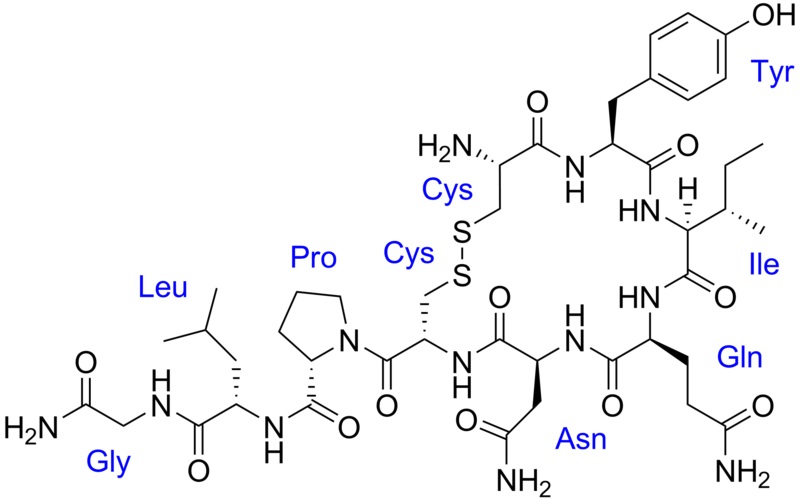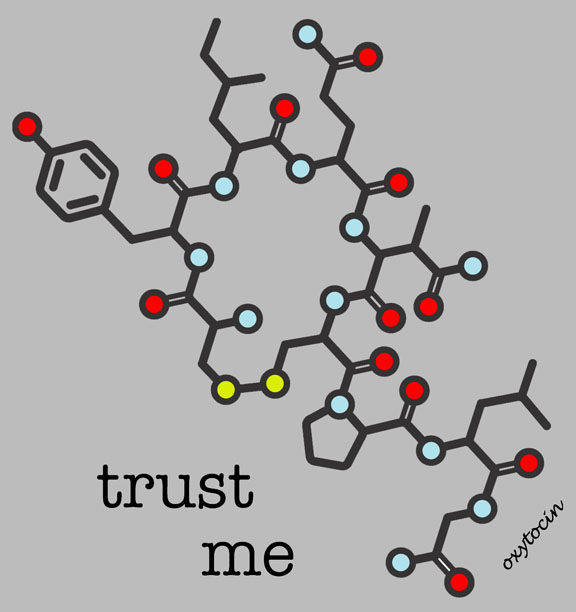Elisa Clivati
Giulia Costagliola
DEFINITION
OT is a peptidic hormone of nine aminoacids; it weights 1007 daltons. Its structure is similar to vasopressin ( ADH) , whose sequence differs only for 2 aminoacids.



SYNTHESIS AND TURNOVER

There are two proteins encoded by this gene, OT and neurophysin I. OT is synthesized as an inactive precursor ( preproprotein ) in the magnocellular neurons of supraoptic and paraventricular nuclei of anterior hypothalamus along with its carrier protein neurophysin I. Together with neurophysin, it is packaged into neurosecretory vesicles (Herring's bodies) and transported axonally to the nerve endings in the neurohypophysis, where it is either stored or secreted into the bloodstream. The last hydrolysis that releases the active OT nonapeptide is catalyzed by peptidylglycine alpha-amidating monooxygenase . The activity of the PAM enzyme system is dependent upon ascorbate, which is a necessary vitamin cofactor.
Transport in the bloodstream
30% of the hormone is carried by plasma proteins; its half life is 3-6 minutes. It is metabolised by hepatic oxytocinases.
Its excretion is renal and biliary.
FUNCTIONS

Receptors
OT's receptors (OTR) belongs to G-protein coupled receptor family. Its activity is mediated by G proteins which activate a phosphatidylinositol-calcium second messenger system. It requires Mg2+ and cholesterol.
OT's receptors are mostly expressed in mammary glands, uterus, SNC. It is thought that OT modulates heart function, inflammatory response, excretion of urine (due to its similarity to vasopressin).
ROLE OF OT IN LABOUR AND LACTATION
*Ferguson's reflex: When the fetus pass through the birth canal, mechanoreceptors are activated and they induce an increased release of OT by the pituitary gland. OT binds its receptors in uterus' myocytes and promotes myometrium contractions. It helps the expulsion of the fetus with a positive feedback loop.
*OT promotes dilatation of the birth canal due to its action on the pelvis.
*OT promotes the expulsion of placenta because its action on the myometrium continues after birth.
*Let-down reflex: Sucking by the infant at the nipple is relayed by spinal nerves to the hypothalamus where intermittent bursts of action potentials induce OT secretion. The myoepithelial cells, surrounding the alveoli of mammary glands, contract under the stimulation of OT thereby milk is excreted from alveolar units into the lobule lumen toward the nipple, where it collects in sinuses of the ducts.
ROLE OF OT ON HUMAN BEHAVIOUR AND SOCIAL BINDINGS
The available published literature converges around the notion that OT increases trust, empathy, eye contact, face memory, and generosity.
Studies on partner preference in rodents
Comparative studies in voles with different social organizations have been useful for identifying the neuroanatomical substrate on which OT acts to promote partner preference formation. For example, monogamous and non-monogamous species of voles have remarkably different distributions of OTR within the brain (the studies focuses on nucleus accumbens). These studies suggest that variation in OT receptor density in the adult directly modulates the ability to form social attachment.
Studies on maternal behaviour in mammals
OT is involved in mediating maternal nurturing, mother-infant bonding, parental behaviour and pair bonding. This raises an intriguing hypothesis about the evolution of pair bonding in monogamous species. Maternal behaviour is present in all mammalian species, while pair bonding has evolved multiple times independently in unrelated monogamous species, and is quite rare. OTRs in the nucleus accumbens are involved in both parental nurturing behaviour and partner preference formation. Vaginocervical stimulation during parturition stimulates central OT release, while similar stimulation during mating bouts also promotes OT release.
Studies on partner preference in humans
It has been shown that OT is increased in the plasma during sexual arousal and ejaculation or orgasm in humans similar to the release seen in prairie voles during mating. Human sexuality may have evolved to promote pair bonding by the incorporation of behaviours that maximize the frequency and extent of OT release during intimacy.
Studies on social cognitions in humans
When administered intranasally to human subjects, OT stimulates behaviours consistent with an enhancement of interpersonal trust during economic games. In fact, when given intranasal, human subjects continue to trust others even after having been betrayed by another. This increase in trust, and lack of feedback following betrayal may be due to a decrease in activation of circuits involved in fear processing, such as the amygdala. Intranasal OT also improves identity recognition memory for neutral and angry faces, independently of participant's gender perhaps by increasing gaze to the eye region of human faces. Another study revealed that OT increased the accuracy of judging a face that the subject previously viewed as familiar. Intranasal OT also improves the ability to infer the emotional state of others based on subtle facial stimuli, a phenomenon referred to as “mind reading”; which could have profound effects on the maintenance of social groups.
Studies on anxiety disorder
In line with animal research showing that OT reduces anxiety, there is evidence that intranasal OT facilitates response to exposure therapy in people with social anxiety disorder. An important extension of this work reported that OT reduces the amygdala activation following threatening stimuli. The results suggest that the OT effect on amygdala activation could be more evident in the response to social threats (faces) versus non-social threats (scenes). In fact, OT appears to reduce the amygdala response to emotional expression irrespective of valence.
Studies on autism
Autism is a developmental disorder with onset by age three of social deficits, absent or abnormal communication, and a tendency to repetitive or stereotyped behaviours. One of the most heavily studied autism candidate genes, reelin, has been associated with changes in the expression of brain OTR. Furthermore it has been reported that there is a marked reduction in OT in children with autism relative to age matched controls. This decrease in circulating OT could be explained by a deficit in processing the peptide from its precursor prohormone. However making inferences to central OT functioning from peripheral measurement is difficult, and this study could not be replicated easily.
Oxytocin and the Neural Mechanisms Regulating Social Cognition and Affiliative Behavior 2010
The Challenge of Translation in Social Neuroscience: A Review of Oxytocin, Vasopressin, and Affiliative Behavior 2011
THERAPEUTIC USE OF OT
Labour inducing
OT must be administered by injection or as nasal spray. OT given intravenously does not enter the brain in significant quantities (it is excluded from the brain by the blood-brain barrier). Injected OT analogues are used for labour induction and to support labour in case of non-progression of parturition. It has largely replaced ergometrine as the principal agent to increase uterine tone in acute postpartum hemorrhage.
Anxiety disorders
OT decreases anxious feelings in humans and may therefore have therapeutic value for anxiety disorders, such as post-traumatic stress disorder (PTSD).
OT reduces background anxiety in a fear-potentiated startle paradigm 2010
Autism
Currently there are no medical treatments for the social and communications deficits that form the core symptoms of autism. Three studies have examined the effects of OT administered intranasally to autistic patients. While not a cure, the results are promising. These initial trials report that, relative to placebo, OT improves eye contact, social memory, and use of social information. These reports should be considered a proof of principle.
